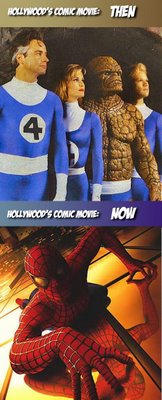The Legitimacy of Sequential Art: Part I - Everything you Know is Wrong, or Comics on Film

What do you really know about comic books?
What is called to mind when someone mentions comic books? Does it consist solely of serialized adventures of spandex clad beings who spout pseudo-science constantly being pressed to the brink and saved by convenient instances of dues ex machina.
Granted, this has been and occasionally is the case in some comic books. The previous description applies to the majority of silver-age comics, and even to some current series that celebrate the nostalgia of classic comics by emulating the campy and unsophisticated stories of the formative years of comic books.
I will also grant you that in every medium, including literature, film and comic books, there are poorly written works. Unfortunately, pop culture embraces the medium of film more easily than any other medium, perhaps becuase of it renders participation virtually unnecessary. Worse still, Hollywood's reductive and revisionist films hardly ever do justice to the origin of its material. Hollywood loves a concept or a name, but all too rarely shows any respect for the heart of the story or medium. How much of what you know of comic books and superheroes is based on what television and movies has distorted for you?
Up until five years ago, Hollywood regularly maligned comic books horribly by creating a self-perpetuating cycle of lowering the average movie-goer’s expectation that further demeaned the genre by offering more films catering to same the a pop-culture understanding Hollywood created .
What Hollywood forgets is the epic quality of comic books. Certain Characters have continued uninterrupted for more than fifty years, often branching out into several different titles. If we were to consider the quality of comics as a continuous art form and relate them to the serials of early film history, some comic book characters would hundreds of hours of “filmed” history.
Truthfully, every issue cannot be counted among this “filmed” history, as comics often undergo ret-conning removing large collections of issues from continuity. Too often comic books continuities are ignored by Hollywood and abandoned to create, as in the case of the ill-fated film, Superman Lives, “‘[re-imaginings]’ which [borrows] the names of [a] franchise and its characters, but little else.”
However, let’s consider one example, the Flash of DC Comics. Discounting every appearance outside of the Flash Volume 2, so as not to include guest appearance in other titles, mini-series, maxi-series, annuals and even the previous volume of the Flash, the series runs 230 issues. The equivalent serialized “filmed” history would be three times that of Heimat 2, which is recognized as the longest film ever produced, lasting more than twenty-five hours.
The point of this “filmed” history is to remind the casual movie goer and non-comic reader that these characters have lives outside and pre-existent to film, and this existence and storied life should be drawn upon, not only to respect the origins and heart of the characters but to also finally embraces the previously established fan-base.
Forget what you “know.” Abandoning every misconception TV and Film offers is one of the first steps to understanding the legitimacy of Sequential Art.


0 Comments:
Post a Comment
<< Home